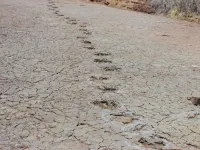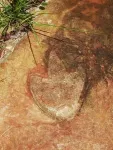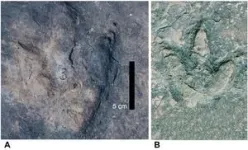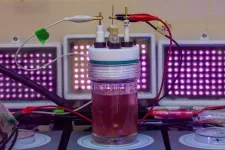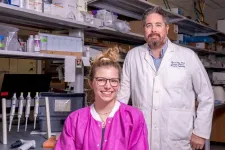(Press-News.org) DALLAS (SMU) – An international team of researchers led by SMU paleontologist Louis L. Jacobs has found matching sets of Early Cretaceous dinosaur footprints on what are now two different continents.
More than 260 footprints were discovered in Brazil and in Cameroon, showing where land-dwelling dinosaurs were last able to freely cross between South America and Africa millions of years ago before the two continents split apart.
“We determined that in terms of age, these footprints were similar,” Jacobs said. “In their geological and plate tectonic contexts, they were also similar. In terms of their shapes, they are almost identical.”
The footprints, impressed into mud and silt along ancient rivers and lakes, were found more than 3,700 miles, or 6,000 kilometers, away from each other. Dinosaurs made the tracks 120 million years ago on a single supercontinent known as Gondwana – which broke off from the larger landmass of Pangea, Jacobs said.
“One of the youngest and narrowest geological connections between Africa and South America was the elbow of northeastern Brazil nestled against what is now the coast of Cameroon along the Gulf of Guinea,” Jacobs explained. “The two continents were continuous along that narrow stretch, so that animals on either side of that connection could potentially move across it.”
Most of the dinosaur fossils were created by three-toed theropod dinosaurs.. A few were also likely made by sauropods or ornithischians, said Diana P. Vineyard, who is a research associate at SMU and co-author of the study.
Other co-authors of the study were Lawrence J. Flynn in the Department of Human Evolutionary Biology at Harvard University, Christopher R. Scotese in the Department of Earth and Planetary Sciences at Northwestern University and Ismar de Souza Carvalho at the Universidade Federal do Rio de Janeiro and Centro de Geociências.
The study was published by New Mexico Museum of Natural History & Science in a tribute to the late paleontologist Martin Lockley, who spent much of his career studying dinosaurs tracks and footprints.
Dinosaur footprints tell the whole story
Africa and South America started to split around 140 million years ago, causing gashes in Earth's crust called rifts to open up along pre-existing weaknesses. As the tectonic plates beneath South America and Africa moved apart, magma from the Earth's mantle rose to the surface, creating new oceanic crust as the continents moved away from each other. And eventually, the South Atlantic Ocean filled the void between these two newly-shaped continents.
Signs of some of those major events were evident between both locations where the dinosaur footprints were found – at the Borborema region in the northeast part of Brazil and the Koum Basin in northern Cameroon. Half-graben basins -- geologic structures formed during rifting as the Earth’s crust pulls apart and faults form -- are found in both areas and contain ancient river and lake sediments. Along with dinosaur tracks, these sediments contain fossil pollen that indicate an age of 120 million years.
Before the continental connection between Africa and South America was severed, “rivers flowed and lakes formed in the basins” Jacobs said. “Plants fed the herbivores and supported a food chain. Muddy sediments left by the rivers and lakes contain dinosaur footprints, including those of meat-eaters, documenting that these river valleys could provide specific avenues for life to travel across the continents 120 million years ago.”
About SMU
SMU is the nationally ranked global research university in the dynamic city of Dallas. SMU’s alumni, faculty and more than 12,000 students in eight degree-granting schools demonstrate an entrepreneurial spirit as they lead change in their professions, communities and the world.
END
Matching dinosaur footprints found on opposite sides of the Atlantic Ocean
Tracks show the last place dinosaurs could travel between Africa and South America before the two continents split
2024-08-25
ELSE PRESS RELEASES FROM THIS DATE:
Turning bacteria into bioplastic factories
2024-08-23
In a world overrun by petroleum-based plastics, scientists are searching for alternatives that are more sustainable, more biodegradable and far less toxic to the environment.
Two new studies by biologists at Washington University in St. Louis highlight one potential source of game-changing materials: purple bacteria that, with a little encouragement, can act like microscopic factories for bioplastics.
A study led by graduate student Eric Conners found that two relatively obscure species of purple bacteria have the ability to produce polyhydroxyalkanoates (PHAs), natural ...
Researcher finds sound progress in babies’ speech development
2024-08-23
The sounds babies make in their first year of life may be less random than previously believed, according to a language development researcher from The University of Texas at Dallas.
Dr. Pumpki Lei Su, an assistant professor of speech, language, and hearing in the School of Behavioral and Brain Sciences, is co-lead author on two recent articles in which researchers examined the sounds babies make. The results suggest that children in their first year are more active than previously thought in their acquisition of speech.
“We observed in these studies that infant vocalizations are not produced randomly; they form a pattern, producing three categories of sounds in clusters,” ...
Two epicenters led to Japan’s violent Noto earthquake on New Year's Day
2024-08-23
Key takeaways
The 7.5- magnitude earthquake beneath Japan’s Noto Peninsula on Jan. 1, 2024, occurred when a “dual-initiation mechanism” applied enough energy from two different locations to break through a fault barrier – an area that locks two sides of a fault in place and absorbs the energy of fault movement, slowing it down or stopping it altogether.
An international team of researchers led by UCLA graduate student Liuwei Xu, professor Lingsen Meng and UC Santa Barbara’s Chen Ji analyzed a preceding seismic swarm and identified a previously unknown barrier in the region of the swarm.
The team’s data collection methods could ...
A leaky sink: Carbon emissions from forest soil will likely grow with rising temperatures
2024-08-23
Photos
The soils of northern forests are key reservoirs that help keep the carbon dioxide that trees inhale and use for photosynthesis from making it back into the atmosphere.
But a unique experiment led by Peter Reich of the University of Michigan is showing that, on a warming planet, more carbon is escaping the soil than is being added by plants.
"This is not good news because it suggests that, as the world warms, soils are going to give back some of their carbon to the atmosphere," said Reich, director of the Institute for Global Change ...
Rice bioengineers develop lotus leaf-inspired system to advance study of cancer cell clusters
2024-08-23
HOUSTON – (Aug. 23, 2024) – The lotus leaf is a pioneer of self-cleaning, water-repellant engineering. Water droplets all but hover on its surface, whose unique texture traps air in its nanosized ridges and folds.
Rice University bioengineers report harnessing the lotus effect to develop a system for culturing cancer cell clusters that can shed light on hard-to-study tumor properties. The new zinc oxide-based culturing surface mimics the lotus leaf surface structure, providing a highly tunable platform for the high-throughput generation of three-dimensional nanoscale tumor models.
The superhydrophobic array device (SHArD) designed by Rice bioengineer Michael King and ...
To mask or not to mask: That is still the question
2024-08-23
CHICAGO --- Despite the association between mask mandates/mask wearing and reduced death rates during the pandemic, masking remains controversial and highly politicized, with many people still asking, “do masks work, and should they be recommended?”
In an editorial about the use of surgical face masks in public, published today, Aug. 23, in The BMJ, Northwestern Medicine internal medicine experts Drs. Jeffrey Linder and Rachel Amdur make the case for masking but acknowledge it’s not a cut-and-dried topic.
The ...
A switch for immune memory and anti-tumor immunity
2024-08-23
AUGUST 23, 2024, NEW YORK – A Ludwig Cancer Research study has identified a metabolic switch in the immune system’s T cells that is essential to the generation of memory T cells—which confer lasting immunity to previously encountered pathogens—and a T cell subtype found in tumors that drives anti-tumor responses during immunotherapy.
Led by Ludwig Lausanne’s Ping-Chih Ho and Alessio Bevilacqua and published in the current issue of Science Immunology, the study identifies PPARβ/δ, a master regulator of gene expression, as that essential molecular switch. Ho, Bevilacqua and their colleagues also show that the switch’s dysfunction compromises ...
Study finds nearly half of U.S. counties have at least one ‘pharmacy desert’
2024-08-23
COLUMBUS, Ohio – Nearly half of counties in the United States have at least one ‘pharmacy desert’ where there is no retail pharmacy within 10 miles, according to a new study published by researchers at The Ohio State University Comprehensive Cancer Center – Arthur G. James Cancer Hospital and Richard J. Solove Research Institute (OSUCCC – James).
“As pharmacies close, more and more Americans are left without easy access to medications, with disproportionate consequences on certain communities. We found that patients in counties with higher social vulnerabilities and fewer primary care providers were up to 40% more likely to reside in a region ...
MSU study finds placebos reduce stress, anxiety, depression — even when people know they are placebos
2024-08-23
MSU has a satellite uplink/LTN TV studio and Comrex line for radio interviews upon request.
EAST LANSING, Mich. – A study out of Michigan State University found that nondeceptive placebos, or placebos given with people fully knowing they are placebos, effectively manage stress — even when the placebos are administered remotely.
Researchers recruited participants experiencing prolonged stress from the COVID-19 pandemic for a two-week randomized controlled trial. Half of the ...
MSU discovers method for CRISPR-based genome editing in Nile grass rats
2024-08-23
EAST LANSING, Mich. – A team of researchers at Michigan State University has discovered a set of methods that enabled the first successful CRISPR-based genome editing in Nile grass rats.
The study, published in BMC Biology, is the first to successfully edit genomes in Nile grass rats. As diurnal rodents, Nile grass rats have similar sleep/awake patterns to humans which could be advantageous in preclinical or translational research.
Currently, preclinical research relies heavily on laboratory mice, which are nocturnal rodents who are active at night and sleep during the day. With these different sleep patterns, diurnal and nocturnal ...
LAST 30 PRESS RELEASES:
Nanoplastics have diet-dependent impacts on digestive system health
Brain neuron death occurs throughout life and increases with age, a natural human protein drug may halt neuron death in Alzheimer’s disease
SPIE and CLP announce the recipients of the 2025 Advanced Photonics Young Innovator Award
Lessons from the Caldor Fire’s Christmas Valley ‘Miracle’
Ant societies rose by trading individual protection for collective power
Research reveals how ancient viral DNA shapes early embryonic development
A molecular gatekeeper that controls protein synthesis
New ‘cloaking device’ concept to shield sensitive tech from magnetic fields
Researchers show impact of mountain building and climate change on alpine biodiversity
Study models the transition from Neanderthals to modern humans in Europe
University of Phoenix College of Doctoral Studies releases white paper on AI-driven skilling to reduce burnout and restore worker autonomy
AIs fail at the game of visual “telephone”
The levers for a sustainable food system
Potential changes in US homelessness by ending federal support for housing first programs
Vulnerability of large language models to prompt injection when providing medical advice
Researchers develop new system for high-energy-density, long-life, multi-electron transfer bromine-based flow batteries
Ending federal support for housing first programs could increase U.S. homelessness by 5% in one year, new JAMA study finds
New research uncovers molecular ‘safety switch’ shielding cancers from immune attack
Bacteria resisting viral infection can still sink carbon to ocean floor
Younger biological age may increase depression risk in older women during COVID-19
Bharat Innovates 2026 National Basecamp Showcases India’s Most Promising Deep-Tech Ventures
Here’s what determines whether your income level rises or falls
SCIE indexation achievement: Celebrate with Space: Science & Technology
Children’s Hospital Colorado performs region’s first pediatric heart and liver dual organ transplant
Australian team discover why quantum computers have memory problems over time
What determines the fate of a T cell?
Candida auris: genetic process revealed which could be treatment target for deadly fungal disease
Groundbreaking discovery turns household plastic recycling into anti-cancer medication
Blocking a key inflammatory pathway improves liver structure and vascular function in cirrhosis, study finds
Continuous spread: Raccoon roundworm detected in nine European countries
[Press-News.org] Matching dinosaur footprints found on opposite sides of the Atlantic OceanTracks show the last place dinosaurs could travel between Africa and South America before the two continents split
